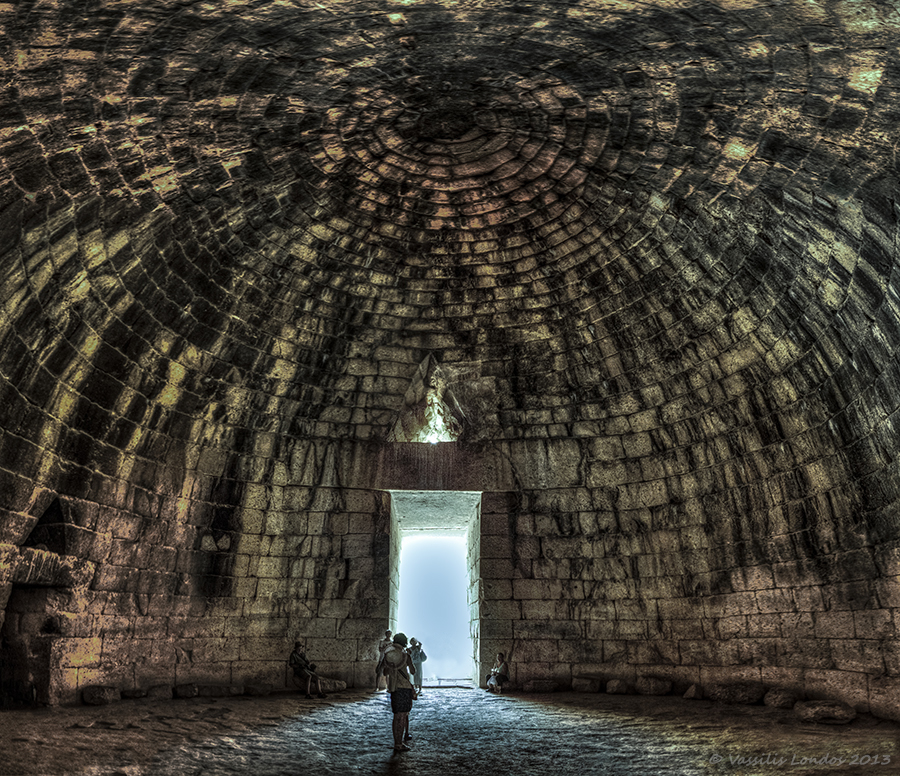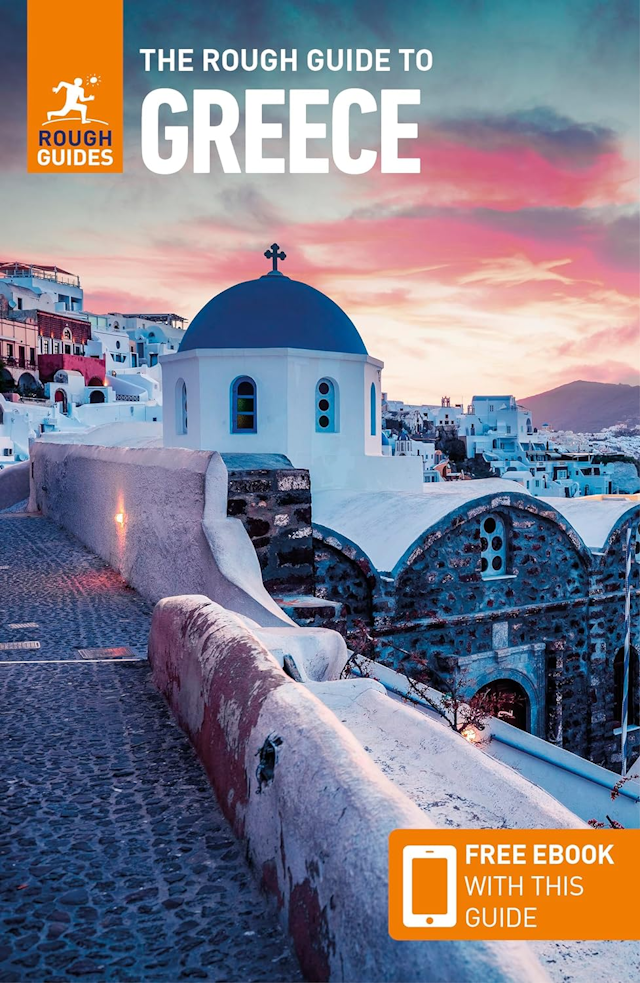- HOME
- Peloponnese
- Mycenae
Mycenae
Mycenae in the Peloponnese was a royal palace and is famous for the royal tombs, Lion Gate, and was excavated by archaeologist Heinrich Schliemann.
Without doubt, Mycenae (or Mykinai) is the most important historical site on the Peloponnese. The great palace of Mycenae was known as the House of Atreus after the ruler of that name. He was the son of Pelops, who gave his name to the Peloponnese (Peloponissos in Greek).
The ruined complex lies just over a mile (2km) outside the modern village of Mycenae, which straddles the main road between Athens and Nafplion, and the ancient site is clearly signposted.
The first thing you see as you approach, on your left, is the Treasury of Atreus. This beehive tomb is a really impressive structure, especially considering that it was built without a scrap of mortar.
You then pass down a long corridor into the main tomb, where the acoustics are startling. Say something out loud to experience this for yourself. Take a look, too, at the hefty lintel over the entrance door, which is 26 feet (8m) long and weighs almost 120 tons.
The Curse on the House of Atreus
Greek dramatists tell the grisly story of the curse on the House of Atreus. Atreus's wife, Aerope, was seduced by his brother, Thyestes. In revenge, Atreus murdered two of Thyestes's sons, boiled them, and then served them to their father at a banquet.
He then showed Thyestes the severed heads of his sons, to let him know what he had just eaten. From then on, Atreus and his descendants - who included Agamemnon, Menelaus, and Orestes - were cursed by the gods.
The Tomb of Agamemnon?
The Treasury at Mycenae is often referred to as the Tomb of Agamemnon, and although it was indeed a royal burial tomb, there is no evidence to support it being the tomb of Agamemnon.
The spot that archaeologist Heinrich Schliemann believed to be the tomb of Agamemnon is at the main site, father along the road. The Treasury dates from the 14th century BC and so would have been used before the time of Agamemnon.
The Lion Gate
The first thing to strike visitors arriving at the main site is the famous Lion Gate, the carved lintel which straddles the entrance. Built in the 13th century BC, it is 12.5 feet (3.75m) wide at the base and almost 11 feet (3.5m) high. Note the grooves in the floor, which were made by chariots, and the holes for bolts at the side to keep the doorway firmly shut, when required.
The Royal Tombs
When you pass through the gate, to your right are the circular remains of the royal tombs. In Grave Circle A, as it is known, six graves were discovered, containing a total of 19 bodies.
This is where Schliemann found the spectacular golden burial mask which he believed was buried with King Agamemnon. In all, 30 pounds (14kg) of gold in the form of masks, jewelry, crowns, and other items were discovered here, and this treasure haul is one of the major attractions in the National Archaeological Museum in Athens.
The Rest of Mycenae
You need to use a certain amount of imagination, and have a map of the site, to make the most of a visit to the rest of Mycenae. There are plenty of foundations to see, and the picture which emerges is of a large royal palace, with huge walls, and an extensive community living just outside the walls and serving the royal court.
The walls themselves were up to 46 feet (14m) thick and were called the Cyclopean Walls, as people later could not understand how they had been built, if not by the one-eyed giants known as the Cyclops.
Destroyed by Fire
The royal palace was destroyed by fire in 1200 BC and the burn marks can still be seen on the foundations that remain. A century later, the site was abandoned and left to decay until its rediscovery by Heinrich Schliemann in 1874. As you wander around today, you can see the remnants of bedchambers, royal apartments, baths, a grand reception hall, and a throne room.
Cyclops
The huge, one-eyed Cyclopes are often maligned, especially due to Odysseus's encounter with the hungry Polyphemus in The Odyssey, but they do have a presence in classical mythology. They play a pivotal role in Homer's The Odyssey, and also appear in Hesiod's Theogony. In the latter, the Cyclopes, banished to Tartarus, are said to have fashioned Zeus's thunderbolts, Artemis's bow, and Poseidon's trident. They also made Perseus's helmet of darkness.
It's quite the resumé, but you have to ask how the idea of a race of one-eyed giants made it into the collective imagination. In 1914, palaeontologist Othenio Abel posited that the skulls of prehistoric elephants might have had something to do with it, as they appear to have only one eye socket, which is actually the nasal cavity. Whether there's any truth in that or not, the myth of the Cyclopes lives on.
Where to Stay/Eat
La Belle Helene
There are several restaurants in modern Mycenae which cater to the lunchtime tourist trade, but the restaurant attached to the Belle Helene hotel is open all year round and every day for lunch and dinner. Check the visitor book, which bears such names as Debussy and Virginia Woolf.
This is also the best of the limited accommodation options near Mycenae, and is where archaeologist Heinrich Schliemann stayed so you can't fault it for historical atmosphere, though it is quite basic. You can even stay in Schliemann's room, as this account in Perceptive Travel describes. Tel: 27510-76225 (restaurant) and 27510-76179 (hotel).
La Belle Helene is good if you want to make an early start at the archaeological site and beat the crowds, but you might also consider staying in Nafplion, which is a half-hour's drive away and has a much better selection of both hotels and restaurants.
Latest Posts
-
Study: Athens Among Best Cities for Family Science Trips
Athens is ranked as one of the top European cities for family science trips, according to a report by Ubuy, a global e-commerce platform. Ubuy’s new report reveals Europe’s top 20 cities where familie… -
May 1: Greece Labor Day Strikes to Halt Public Transport, Ferries
Transportation and travel in Greece will be disrupted on Wednesday, May 1, as public transport and ferry employees have announced their participation in strike mobilizations to mark May Day. According… -
Technopolis: New 3-day Beer Festival Coming to Athens in May
A new beer festival is coming to Athens and for three days will quench the thirst of beer lovers with well-known and rare labels from around the world as well as from Greek microbreweries. Lager? Pils… -
5 Reasons to Spend Easter in Meteora
Renowned for its spectacular “hanging” monasteries and reverent atmosphere, Meteora is the perfect place to spend Greek Easter. -
3 Must-Visit Islands for Greek Easter
Boasting spectacular landscapes and unique local traditions, the islands of Lesvos, Ikaria and Andros are ideal vacation destinations for Greek Easter. -
Easter Cookies from Smyrna, a 100-Year-Old Recipe
Discover the secret to making the most delicious Easter koulourakia (cookies) from Smyrna, passed down through five generations. -
Greece Launches Contactless ‘Tap & Pay’ System on Athens Airport Express Buses
The Greek Transport Ministry on Wednesday launched a pilot ‘Tap & Pay’ contactless payment system for passengers traveling on the express bus lines in Athens that connect to Athens International Airpo… -
Acropolis Museum Exhibition: The Parthenon and Byron
On the occasion of 200 years since Lord Byron’s death, the Acropolis Museum in Athens is honoring his memory with a symbolic exhibition related to Lord Elgin’s taking of the Parthenon sculptures. -
Greece Bans Sunbeds, Umbrellas, Bars on 198 Beaches
Sunbeds, umbrellas, and all sorts of constructions have been banned on 198 beaches across Greece according to a joint ministerial decision signed this week by Economy & Finance Minister Kostis Hatzida… -
4 Guesthouses in Zagori that Are Worth Visiting
Amidst the mountains and spectacular scenery, these four traditional guesthouses in the heart of Zagori, Epirus, offer the very best in Greek hospitality.




























